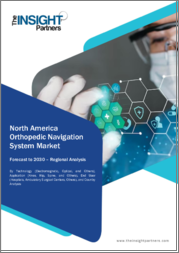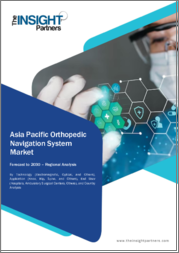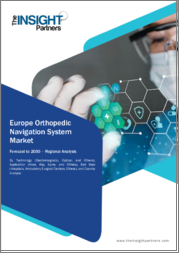
|
시장보고서
상품코드
1625288
세계의 정형외과용 내비게이션 시스템 시장 예측(-2030년) : 유형, 기술, 용도, 최종 사용자, 지역별 분석Orthopedic Navigation Systems Market Forecasts to 2030 - Global Analysis By Type (2D Navigation Systems, 3D Navigation Systems, Computer-Assisted Surgery Systems and Other Types), Technology, Application, End User and By Geography |
||||||
Stratistics MRC에 따르면 정형외과용 내비게이션 시스템 세계 시장은 2024년에 28억 달러를 차지하고 예측 기간 동안 CAGR은 15.9%로 성장하고 2030년에는 67억 달러에 이를 전망입니다.
정형외과 네비게이션 시스템은 정형외과 수술의 정확성, 정확성 및 성과를 향상시키는 데 사용되는 첨단 기술입니다. 수술 중 외과 의사를 유도합니다. 이 시스템은 환자의 해부학 구조를 3D로 상세하게 시각화하고 임플란트의 배치, 정렬, 절개를 보다 정확하게 수행할 수 있습니다. 수술 결과 향상, 실수 감소, 회복 가속화, 수술 외상 최소화 등이 있습니다.
2023년 2월에 Journal of the American Academy of Orthopedic Surgeons가 발표한 논문에 따르면, 발관절의 저침습 수술(MIS)의 인기는 급상승하고 있습니다.
정형외과 질환의 유병률 증가
골관절염, 척추관 협착증, 골절 등 정형외과 질환의 환자 수가 증가함에 따라 정확한 수술 개입의 필요성이 증가하고 있습니다. 수술, 골절 수리시 정확도를 높이고 인위적 실수를 최소화해, 환자의 결과를 개선합니다. 또한, 세계의 노화는 정형외과 질환의 유병률 증가의 주요 요인이며, 의료 제공업체는 고품질의 수술을 보장하고 노인 환자의 삶 품질을 향상시키기 위해 이러한 시스템에 대한 의존도를 높이고 있습니다.
경제적 제약에 의한 제한적인 채용
정형외과 네비게이션 시스템은 특히 소득이 낮은 지역과 소규모 클리닉에서 초기 구매, 설치 및 유지 보수에 비용이 많이 들기 때문에 비용이 많이 듭니다. 영상 처리 장치나 추적 시스템 등의 특수한 기기가 필요하기 때문에 헬스 케어 프로바이더에는 너무 비싼 경우도 있어, 많은 시설이 종래의 저렴한 방법을 선택하게 되어, 네비게이션 기술의 보급을 방해하고 있기 때문에 시장 성장을 방해하고 있습니다.
낮은 침습 수술 채택
정형외과용 네비게이션 시스템은 무릎이나 고관절의 치환술이나 척추 수술과 같은 저침습 정형외과 수술에 있어서 정확한 정렬, 조직 손상의 경감, 조기 회복에 매우 중요합니다. 이러한 기술이 보급됨에 따라 이러한 시스템에 대한 수요도 높아질 것으로 예상됩니다. 이 시스템은 실시간 지침을 제공하고 수술 부위에 대한 시야 및 접근 제한과 같은 과제를 극복함으로써 낮은 침습 수술의 정확성을 높이고 시장 성장을 가속하고 있습니다.
숙련된 외과의 부족
정형외과 네비게이션 시스템을 낮은 침습 수술에 통합하려면 두 기술을 모두 숙련된 숙련된 외과 의사가 필요합니다. 그러나 이러한 고급 절차의 채택은 훈련받은 전문가의 부족에 의해 방해받을 수 있습니다. 교육 프로그램이 증가하고 있음에도 불구하고 정형외과 네비게이션 시스템의 사용을 전문으로 하는 외과의사는 여전히 적고, 특정 지역 및 의료 환경에서의 도입이 지연될 수 있습니다.
COVID-19의 영향
COVID-19의 대유행은 선택 수술 지연과 병원 예산 감소로 정형외과용 네비게이션 시스템 시장에 큰 영향을 미쳤습니다. 선호하기 위해 연기되며 내비게이션 시스템 수요가 일시적으로 감소했습니다. 그러나, 유행 후에 선택 수술이 재개되면, 시장은 회복하기 시작했습니다. 시장의 완만한 성장을 견인하고 있습니다.
예측 기간 동안 2D 내비게이션 시스템 분야가 최대화될 전망
X 선 및 투시 이미지를 통한 실시간 지침을 통해 외과의 사는 수술 중에 장비와 해부학 적 구조를 추적 할 수 있습니다. 보다 이미지의 선명도와 정밀도가 향상되어 2D 시스템과 3D 시스템의 갭을 메우고 있습니다.
예측 기간 동안 CAGR이 가장 높을 것으로 예상되는 것은 투시 검사 분야입니다.
X 선 투시 검사는 실시간으로 연속적인 X 선 영상을 제공하고 외과 의사가 수술 중에 수술기구와 해부학 적 구조를 모니터링 할 수 있기 때문에 예측 기간 동안 큰 성장이 예상됩니다. 뼈 구조와 연부 조직의 정확한 시각화는 수작업으로 인한 실수를 최소화하고 인공 관절 치환술과 척추 수술과 같은 절차에서 정렬을 개선합니다. 시장 성장을 가속합니다.
최대 점유율을 차지하는 지역:
북미는 기술의 진보와 정형외과 질환의 유병률 상승에 견인되어 예측 기간 동안 시장에서 가장 큰 점유율을 차지할 것으로 예상됩니다. 관련 관절 변성과 같은 요인이 높습니다. 정교한 수술 솔루션 수요에 기여합니다. 정형외과 네비게이션 시스템은 인공 관절 대체, 척추 수술 및 외상 관리의 정확성을 높이고 합병증을 줄이고 환자의 결과를 향상시키는 데 필수적입니다.
CAGR이 가장 높은 지역:
예측 기간 동안 아시아태평양이 가장 높은 성장률을 나타낼 것으로 예상됩니다. 합병증을 줄이기 위해서입니다. 일본과 한국과 같은 신흥 경제 국가에서 로봇 지원 수술을 채택하는 것은 특히 인공 관절 대체 및 척추 수술과 같은 복잡한 수술에서 의료 관광 증가와 고급 의료 기술에 대한 액세스 개선으로, 상황을 일변시키고 있습니다.
무료 주문을 받아서 만드는 서비스:
이 보고서를 구독하는 고객은 다음 무료 맞춤설정 옵션 중 하나를 사용할 수 있습니다.
- 기업 프로파일
- 추가 시장 기업의 종합적 프로파일링(3개사까지)
- 주요 기업의 SWOT 분석(3개사까지)
- 지역 세분화
- 고객의 관심에 응한 주요국 시장 추계·예측·CAGR(주: 타당성 확인에 따름)
- 경쟁 벤치마킹
- 제품 포트폴리오, 지리적 존재, 전략적 제휴에 기반한 주요 기업 벤치마킹
목차
제1장 주요 요약
제2장 서문
- 개요
- 이해관계자
- 조사 범위
- 조사 방법
- 데이터 마이닝
- 데이터 분석
- 데이터 검증
- 조사 접근
- 조사 정보원
- 1차 조사 정보원
- 2차 조사 정보원
- 전제조건
제3장 시장 동향 분석
- 성장 촉진요인
- 억제요인
- 기회
- 위협
- 기술 분석
- 용도 분석
- 최종 사용자 분석
- 신흥 시장
- COVID-19의 영향
제4장 Porter's Five Forces 분석
- 공급기업의 협상력
- 구매자의 협상력
- 대체품의 위협
- 신규 참가업체의 위협
- 경쟁 기업간 경쟁 관계
제5장 세계의 정형외과용 내비게이션 시스템 시장 : 유형별
- 2D 내비게이션 시스템
- 3D 내비게이션 시스템
- 컴퓨터 지원 수술 시스템
- 기타 유형
제6장 세계의 정형외과용 내비게이션 시스템 시장 : 기술별
- 전자
- 광학
- 투시 검사
- 자기 공명 화상
- 기타 기술
제7장 세계의 정형외과용 내비게이션 시스템 시장 : 용도별
- 무릎 관절 치환 수술
- 고관절 치환 수술
- 척추 수술
- 기타 용도
제8장 세계의 정형외과용 내비게이션 시스템 시장 : 최종 사용자별
- 병원
- 외래수술센터(ASC)
- 정형외과 클리닉
- 조사 및 학술기관
- 기타 최종 사용자
제9장 세계의 정형외과용 내비게이션 시스템 시장 :지역별
- 북미
- 미국
- 캐나다
- 멕시코
- 유럽
- 독일
- 영국
- 이탈리아
- 프랑스
- 스페인
- 기타 유럽
- 아시아태평양
- 일본
- 중국
- 인도
- 호주
- 뉴질랜드
- 한국
- 기타 아시아태평양
- 남미
- 아르헨티나
- 브라질
- 칠레
- 기타 남미
- 중동 및 아프리카
- 사우디아라비아
- 아랍에미리트(UAE)
- 카타르
- 남아프리카
- 기타 중동 및 아프리카
제10장 주요 발전
- 계약, 파트너십, 협업, 합작 투자
- 인수와 합병
- 신제품 발매
- 사업 확대
- 기타 주요 전략
제11장 기업 프로파일링
- Amplitude Surgical
- B. Braun SE
- Brainlab
- DePuy Synthes(Johnson & Johnson Services, Inc.)
- Exactech, Inc.
- Globus Medical
- Kinamed Incorporated
- Medtronic PLC
- MicroPort Medical
- NuVasive
- OrthAlign
- Pixee Medical
- Siemens Healthineers
- Smith Nephew
- Stryker
- Tynor
- Zimmer Biomet
- Arthrex Inc.
According to Stratistics MRC, the Global Orthopedic Navigation Systems Market is accounted for $2.8 billion in 2024 and is expected to reach $6.7 billion by 2030 growing at a CAGR of 15.9% during the forecast period. Orthopedic navigation systems are advanced technologies used in orthopedic surgeries to enhance precision, accuracy, and outcomes. They use real-time imaging and computer software to guide surgeons during procedures like joint replacements, spinal surgery, and fracture fixation. These systems provide detailed 3D visualizations of the patient's anatomy, enabling more accurate placement of implants, alignment, and incisions. They also include tracking devices attached to surgical tools to monitor their position relative to the patient's body. Benefits include better surgical outcomes, reduced errors, faster recovery, and minimized surgical trauma.
According to an article published by the Journal of the American Academy of Orthopedic Surgeons in February 2023, minimally invasive surgery (MIS) of the foot and ankle is experiencing a surge in popularity.
Market Dynamics:
Driver:
Increasing prevalence of orthopedic conditions
As the number of individuals with orthopedic conditions like osteoarthritis, scoliosis, and fractures increases, there is a growing need for accurate surgical interventions. Orthopedic navigation systems offer enhanced precision during joint replacements, spinal surgeries, and fracture repair, minimizing human error and improving patient outcomes. Further the global aging population is a primary driver of the increased prevalence of orthopedic conditions, making healthcare providers increasingly relying on these systems to ensure high-quality surgeries and improve the quality of life for elderly patients.
Restraint:
Limited adoption due to financial constraints
Orthopedic navigation systems are costly, particularly in lower-income regions or smaller practices, due to the initial purchase, installation, and maintenance costs. The specialized equipment required, such as imaging devices and tracking systems, can be unaffordable for healthcare providers, leading many facilities to opt for traditional, less expensive methods, hindering the widespread adoption of navigation technologies thus hampering the market growth.
Opportunity:
Adoption of minimally invasive surgical procedures
Orthopedic navigation systems are crucial for precise alignment, tissue damage reduction, and faster recovery in minimally invasive orthopedic surgeries like knee and hip replacements or spinal surgeries. As these techniques gain popularity, the demand for these systems is expected to rise. These systems offer real-time guidance, overcoming challenges like limited visibility and access to surgical sites, thereby enhancing the precision of minimally invasive surgical procedures thus encouraging the market growth.
Threat:
Limited availability of skilled surgeons
The integration of orthopedic navigation systems into minimally invasive surgeries requires skilled surgeons trained in both technologies. However, the adoption of these advanced procedures can be hindered by a shortage of trained professionals. Despite increasing training programs, there are still fewer surgeons specializing in using orthopedic navigation systems, which could slow their adoption in specific regions or healthcare settings.
Covid-19 Impact
The COVID-19 pandemic significantly impacted the Orthopedic Navigation Systems Market due to delayed elective surgeries and reduced hospital budgets. Orthopedic procedures, such as joint replacements and spine surgeries, were postponed to prioritize critical care, leading to a temporary decline in demand for navigation systems. However, as elective surgeries resumed post-pandemic, the market began to recover. The focus on precision and efficient surgeries has renewed interest in orthopedic navigation systems, driving gradual market growth.
The 2D navigation systems segment is expected to be the largest during the forecast period
Over the forecasted timeframe, the 2D segment is anticipated to dominate the market share owing to real-time guidance through X-rays or fluoroscopic images, enabling surgeons to track instruments and anatomical structures during surgery. They are easier to use due to simpler image sets compared to 3D systems. Advances in software are improving image clarity and accuracy, bridging the gap between 2D and 3D systems. 2D systems can integrate seamlessly with existing fluoroscopy or X-ray machines, eliminating additional investments and enabling rapid deployment.
The fluoroscopy segment is expected to have the highest CAGR during the forecast period
The fluoroscopy segment is anticipated to witness substantial growth during the estimation period as it provides continuous X-ray imaging in real-time, allowing surgeons to monitor surgical instruments and anatomical structures during procedures. This real-time feedback ensures precise placement of implants and instruments. Accurate visualization of bone structures and soft tissues minimizes manual errors, leading to better alignment in procedures such as joint replacements and spinal surgeries boosting the growth of the market.
Region with largest share:
The North America region is expected to hold the largest share of the market during the forecast period driven by technological advancements and a rising prevalence of orthopedic conditions. Factors such as an aging population, increasing cases of osteoporosis and arthritis, and lifestyle-related joint degeneration are contributing to the demand for advanced surgical solutions. Orthopedic navigation systems have become indispensable for improving precision in joint replacement, spine surgeries, and trauma management, reducing complications, and enhancing patient outcomes.
Region with highest CAGR:
During the estimation period, the Asia Pacific region is anticipated to record the highest growth rate owing to the integration of orthopedic navigation systems with advanced imaging technologies, such as CT, MRI, and fluoroscopy, enhances surgical precision and reduces complications. Additionally, the adoption of robotic-assisted surgeries in developed economies like Japan and South Korea is transforming the landscape, particularly for complex procedures such as joint replacements and spine surgeries driven by increasing medical tourism and improving access to advanced healthcare technologies.
Key players in the market
Some of the key players in Orthopedic Navigation Systems market include Amplitude Surgical, B. Braun SE, Brainlab, DePuy Synthes (Johnson & Johnson Services, Inc.), Exactech, Inc., Globus Medical, Kinamed Incorporated, Medtronic PLC, MicroPort Medical, NuVasive, OrthAlign, Pixee Medical, Siemens Healthineers, Smith+Nephew, Stryker, Tynor, Zimmer Biomet and Arthrex Inc.
Key Developments:
In December 2024, Siemens Healthineers announced the acquisition of Advanced Accelerator Applications Molecular Imaging from Novartis. This strategic move expands Siemens Healthineers' network of PET radiopharmaceutical production sites across Europe, enhancing their capabilities in supporting patients with cancer, heart disease, and neurological disorders.
In November 2024, Medtronic plc announced U.S. Food and Drug Administration (FDA) clearance for its new InPen(TM) app featuring missed meal dose detection, paving the way for the launch of its Smart MDI system with the Simplera(TM) continuous glucose monitor (CGM).
In September 2024, Medtronic plc announced at the North American Spine Society (NASS) 39th Annual Meeting in Chicago the commercial launch of several software, hardware, and imaging innovations. These enhancements are designed to advance AiBLE(TM), the Medtronic smart ecosystem of innovative navigation, robotics.
Types Covered:
- 2D Navigation Systems
- 3D Navigation Systems
- Computer-Assisted Surgery Systems
- Other Types
Technologies Covered:
- Electromagnetic
- Optical
- Fluoroscopy
- Magnetic Resonance Imaging
- Other Technologies
Applications Covered:
- Knee Replacement Surgery
- Hip Replacement Surgery
- Spinal Surgery
- Other Applications
End Users Covered:
- Hospitals
- Ambulatory Surgical Centers
- Orthopedic Clinics
- Research & Academic Institutions
- Other End Users
Regions Covered:
- North America
- US
- Canada
- Mexico
- Europe
- Germany
- UK
- Italy
- France
- Spain
- Rest of Europe
- Asia Pacific
- Japan
- China
- India
- Australia
- New Zealand
- South Korea
- Rest of Asia Pacific
- South America
- Argentina
- Brazil
- Chile
- Rest of South America
- Middle East & Africa
- Saudi Arabia
- UAE
- Qatar
- South Africa
- Rest of Middle East & Africa
What our report offers:
- Market share assessments for the regional and country-level segments
- Strategic recommendations for the new entrants
- Covers Market data for the years 2022, 2023, 2024, 2026, and 2030
- Market Trends (Drivers, Constraints, Opportunities, Threats, Challenges, Investment Opportunities, and recommendations)
- Strategic recommendations in key business segments based on the market estimations
- Competitive landscaping mapping the key common trends
- Company profiling with detailed strategies, financials, and recent developments
- Supply chain trends mapping the latest technological advancements
Free Customization Offerings:
All the customers of this report will be entitled to receive one of the following free customization options:
- Company Profiling
- Comprehensive profiling of additional market players (up to 3)
- SWOT Analysis of key players (up to 3)
- Regional Segmentation
- Market estimations, Forecasts and CAGR of any prominent country as per the client's interest (Note: Depends on feasibility check)
- Competitive Benchmarking
- Benchmarking of key players based on product portfolio, geographical presence, and strategic alliances
Table of Contents
1 Executive Summary
2 Preface
- 2.1 Abstract
- 2.2 Stake Holders
- 2.3 Research Scope
- 2.4 Research Methodology
- 2.4.1 Data Mining
- 2.4.2 Data Analysis
- 2.4.3 Data Validation
- 2.4.4 Research Approach
- 2.5 Research Sources
- 2.5.1 Primary Research Sources
- 2.5.2 Secondary Research Sources
- 2.5.3 Assumptions
3 Market Trend Analysis
- 3.1 Introduction
- 3.2 Drivers
- 3.3 Restraints
- 3.4 Opportunities
- 3.5 Threats
- 3.6 Technology Analysis
- 3.7 Application Analysis
- 3.8 End User Analysis
- 3.9 Emerging Markets
- 3.10 Impact of Covid-19
4 Porters Five Force Analysis
- 4.1 Bargaining power of suppliers
- 4.2 Bargaining power of buyers
- 4.3 Threat of substitutes
- 4.4 Threat of new entrants
- 4.5 Competitive rivalry
5 Global Orthopedic Navigation Systems Market, By Type
- 5.1 Introduction
- 5.2 2D Navigation Systems
- 5.3 3D Navigation Systems
- 5.4 Computer-Assisted Surgery Systems
- 5.5 Other Types
6 Global Orthopedic Navigation Systems Market, By Technology
- 6.1 Introduction
- 6.2 Electromagnetic
- 6.3 Optical
- 6.4 Fluoroscopy
- 6.5 Magnetic Resonance Imaging
- 6.6 Other Technologies
7 Global Orthopedic Navigation Systems Market, By Application
- 7.1 Introduction
- 7.2 Knee Replacement Surgery
- 7.3 Hip Replacement Surgery
- 7.4 Spinal Surgery
- 7.5 Other Applications
8 Global Orthopedic Navigation Systems Market, By End User
- 8.1 Introduction
- 8.2 Hospitals
- 8.3 Ambulatory Surgical Centers
- 8.4 Orthopedic Clinics
- 8.5 Research & Academic Institutions
- 8.6 Other End Users
9 Global Orthopedic Navigation Systems Market, By Geography
- 9.1 Introduction
- 9.2 North America
- 9.2.1 US
- 9.2.2 Canada
- 9.2.3 Mexico
- 9.3 Europe
- 9.3.1 Germany
- 9.3.2 UK
- 9.3.3 Italy
- 9.3.4 France
- 9.3.5 Spain
- 9.3.6 Rest of Europe
- 9.4 Asia Pacific
- 9.4.1 Japan
- 9.4.2 China
- 9.4.3 India
- 9.4.4 Australia
- 9.4.5 New Zealand
- 9.4.6 South Korea
- 9.4.7 Rest of Asia Pacific
- 9.5 South America
- 9.5.1 Argentina
- 9.5.2 Brazil
- 9.5.3 Chile
- 9.5.4 Rest of South America
- 9.6 Middle East & Africa
- 9.6.1 Saudi Arabia
- 9.6.2 UAE
- 9.6.3 Qatar
- 9.6.4 South Africa
- 9.6.5 Rest of Middle East & Africa
10 Key Developments
- 10.1 Agreements, Partnerships, Collaborations and Joint Ventures
- 10.2 Acquisitions & Mergers
- 10.3 New Product Launch
- 10.4 Expansions
- 10.5 Other Key Strategies
11 Company Profiling
- 11.1 Amplitude Surgical
- 11.2 B. Braun SE
- 11.3 Brainlab
- 11.4 DePuy Synthes (Johnson & Johnson Services, Inc.)
- 11.5 Exactech, Inc.
- 11.6 Globus Medical
- 11.7 Kinamed Incorporated
- 11.8 Medtronic PLC
- 11.9 MicroPort Medical
- 11.10 NuVasive
- 11.11 OrthAlign
- 11.12 Pixee Medical
- 11.13 Siemens Healthineers
- 11.14 Smith+Nephew
- 11.15 Stryker
- 11.16 Tynor
- 11.17 Zimmer Biomet
- 11.18 Arthrex Inc.


















